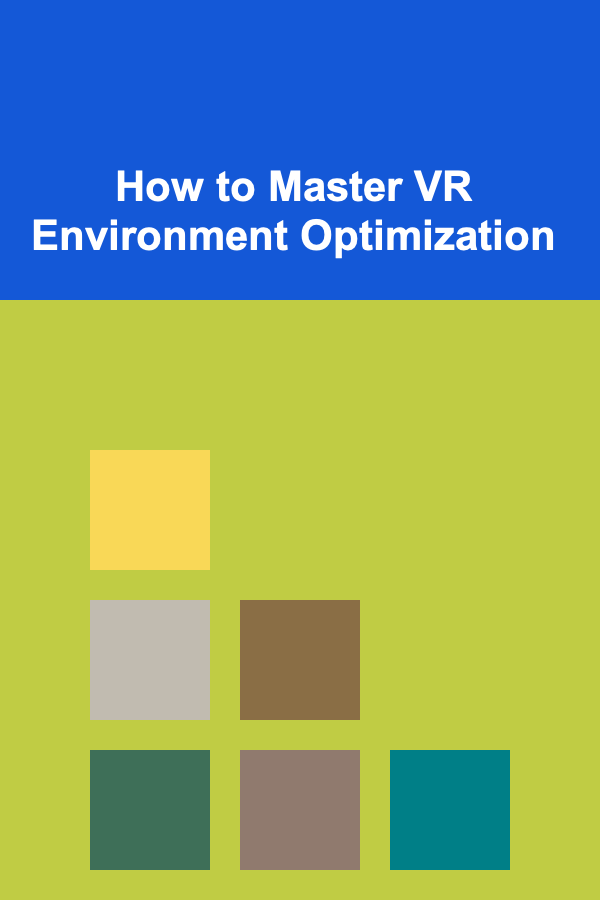How to Use a Kanban Board as a Task Tracker
ebook include PDF & Audio bundle (Micro Guide)
$12.99$10.99
Limited Time Offer! Order within the next:
Not available at this time
The Kanban board is a highly effective tool used for visualizing work, maximizing efficiency, and improving workflow in various types of work environments. It originated from the manufacturing industry but has since been adapted for use in a wide range of sectors, from software development to personal productivity. In this article, we will dive deep into how to use a Kanban board as a task tracker, exploring its history, principles, benefits, and how to set it up for various uses.
What Is a Kanban Board?
The term "Kanban" comes from the Japanese word for "visual signal" or "card." In its original form, it was used by Toyota as part of their Just-In-Time (JIT) manufacturing system to manage and improve the flow of materials on the factory floor. Over time, the Kanban method was adapted to software development and project management, where it focuses on visualizing tasks as they move through various stages of work.
A Kanban board typically consists of columns representing different stages of work and cards that represent individual tasks or work items. The tasks are moved from one column to the next as they progress through the workflow.
Key Principles of Kanban
Before we dive into how to use a Kanban board for tracking tasks, it is essential to understand the underlying principles of the Kanban method. These principles are fundamental to effectively managing tasks and workflow.
- Visualize the Workflow: The Kanban board provides a clear, visual representation of the entire workflow. Tasks are displayed in different stages, making it easy to see where work is and what needs to be done next.
- Limit Work in Progress (WIP): By limiting the number of tasks in any given stage of the process, the Kanban method helps prevent overloading the team or individual workers. This focus on finishing tasks before starting new ones improves productivity and reduces bottlenecks.
- Manage Flow: Kanban encourages the smooth movement of tasks through the process. It involves monitoring and improving the flow of work, ensuring that tasks are completed in a timely manner and that any issues are addressed before they slow down the entire process.
- Make Process Policies Explicit: Clear, agreed-upon policies are crucial to the success of a Kanban system. These policies might include how tasks should be handled, how work is prioritized, and what defines the completion of a task.
- Improve Continuously: One of the key aspects of Kanban is continuous improvement. Teams are encouraged to regularly evaluate their processes, identify areas for improvement, and make incremental changes to enhance efficiency.
How to Set Up a Kanban Board
Setting up a Kanban board involves a few simple steps. It can be done digitally or on a physical board, depending on your preference. Let's walk through the process of setting up a Kanban board to track tasks.
Step 1: Choose a Platform
Kanban boards can be physical (using a whiteboard, sticky notes, and markers) or digital (using tools like Trello, Jira, Asana, or others). If you are managing a small personal project, a physical board may be sufficient. However, digital platforms are more versatile and scalable, especially for larger teams or remote work.
Step 2: Define the Columns
Columns represent the different stages of work that tasks will pass through. The typical stages are:
- Backlog: This column holds tasks that are planned but not yet started. It's a place to store upcoming work.
- To Do: Tasks that are ready to be worked on are placed here.
- In Progress: Tasks that are actively being worked on are moved to this column.
- Review: Once a task is completed, it may need to be reviewed before it is considered finished.
- Done: Tasks that are fully completed and no longer need attention are moved to this column.
The exact names of the columns can vary based on your workflow and the type of project you're working on. Some people may add additional columns, such as "Blocked," "Testing," or "In Progress (Team A)."
Step 3: Create Task Cards
Each task is represented by a card. In physical Kanban boards, this would be a sticky note, while in digital tools, it's an item within the software. Each card should include the following elements:
- Task Title: A short description of the task.
- Task Description: A more detailed explanation of what needs to be done.
- Deadline: If applicable, the due date for the task.
- Priority: The priority of the task, whether it's high, medium, or low.
- Assignee: Who is responsible for completing the task.
Task cards should be moved from one column to the next as they progress through the workflow. This movement represents the task's progression from concept to completion.
Step 4: Set Work in Progress (WIP) Limits
WIP limits are one of the most important aspects of a Kanban board. They help prevent teams from being overwhelmed by too many tasks in progress at once, which can lead to decreased productivity and missed deadlines.
For example, you may decide to limit the "In Progress" column to five tasks. If there are already five tasks in progress, no additional tasks can be started until one of the existing tasks is completed or moved forward. This focus on completing tasks before starting new ones helps increase throughput and reduces multitasking.
Step 5: Monitor and Adjust
Once your Kanban board is set up, you can begin using it to track your tasks. It's important to monitor the flow of work regularly. If you notice bottlenecks---where tasks are piling up in a particular column---this may indicate that additional resources are needed or that there's a process issue to address.
Kanban also emphasizes continuous improvement. Regularly review the board with your team (or yourself, if it's a personal project), reflect on what is working well, and make small adjustments to improve efficiency.
How to Use a Kanban Board for Personal Task Tracking
While Kanban boards are often associated with team projects, they can also be an excellent tool for personal task management. Here's how you can use a Kanban board to stay organized and improve your personal productivity.
- Define Your Workflow: For personal task tracking, you may not need as many columns as a team project. A simple "To Do," "In Progress," and "Done" setup might be sufficient. You can also add a "Someday/Maybe" column for tasks that are not urgent.
- Prioritize Your Tasks: Personal projects often involve a wide variety of tasks, and it's essential to prioritize them. Assign a priority level to each task and focus on completing high-priority tasks first.
- Use WIP Limits: Even in personal task tracking, limiting how many tasks you work on at once can help you stay focused. If you have multiple things on your plate, don't start something new until you've completed an existing task.
- Track Progress and Reflect: The beauty of the Kanban board is that it provides a clear visual representation of what you've accomplished and what's left to do. Use this to motivate yourself and reflect on your productivity over time.
How to Use a Kanban Board for Team Task Management
Kanban boards are most commonly used in team settings, where multiple people collaborate on tasks. Here's how to use a Kanban board for team task management.
- Collaborative Workflow: In a team environment, the Kanban board should represent the collective workflow. Assign tasks to team members and use the board to track the progress of each individual task.
- Set Team-Wide WIP Limits: In addition to limiting WIP within individual columns, you can also set team-wide WIP limits. This ensures that no one person is overloaded with too many tasks.
- Use Custom Columns for Different Teams: If you have multiple teams working on different aspects of a project, you can create custom columns for each team. For example, "Design," "Development," and "Testing" columns could be used to track work from different teams.
- Regular Meetings for Continuous Improvement: Hold regular stand-up meetings or retrospective sessions to reflect on the Kanban process. These meetings allow teams to discuss bottlenecks, celebrate successes, and make necessary adjustments to improve workflow.
Benefits of Using a Kanban Board as a Task Tracker
The benefits of using a Kanban board as a task tracker are numerous, and they apply to both individual and team productivity.
1. Improved Visibility
One of the most significant advantages of a Kanban board is its ability to provide a clear, visual representation of tasks and their status. Whether working alone or with a team, the board allows you to see where everything stands at a glance, which can increase focus and clarity.
2. Increased Efficiency
By limiting WIP and focusing on completing tasks before starting new ones, the Kanban system helps streamline workflow. This leads to fewer distractions, less multitasking, and an increase in overall efficiency.
3. Enhanced Collaboration
Kanban boards improve communication and collaboration, particularly in team environments. Team members can easily see what others are working on, identify bottlenecks, and offer help if needed. This transparency fosters better teamwork and problem-solving.
4. Flexibility and Adaptability
The simplicity of the Kanban method allows it to be adapted to a wide variety of projects and workflows. Whether you're managing a personal project or leading a team of hundreds, a Kanban board can be customized to meet your specific needs.
5. Continuous Improvement
Kanban emphasizes the importance of ongoing improvement. By regularly reviewing the board, teams can identify areas of inefficiency, address issues, and make adjustments to optimize the workflow.
Conclusion
The Kanban board is a versatile and powerful tool for task tracking and project management. Whether used for personal productivity or team collaboration, it provides a clear and efficient way to manage tasks, improve workflow, and boost overall productivity. By implementing Kanban, you can create a system that helps you prioritize tasks, reduce bottlenecks, and continually refine your processes to achieve better results.

How to Choose the Right Investment Strategy for Your Risk Tolerance
Read More
How to Make Your Home More Comfortable for Elderly Pets
Read More
How to Perform Regular Maintenance on Your Home's Appliances
Read More
The Role of Online Portfolios in Creative Job Searches
Read More
How to Master VR Environment Optimization
Read More
How to Harvest Wind Energy at Home
Read MoreOther Products

How to Choose the Right Investment Strategy for Your Risk Tolerance
Read More
How to Make Your Home More Comfortable for Elderly Pets
Read More
How to Perform Regular Maintenance on Your Home's Appliances
Read More
The Role of Online Portfolios in Creative Job Searches
Read More
How to Master VR Environment Optimization
Read More